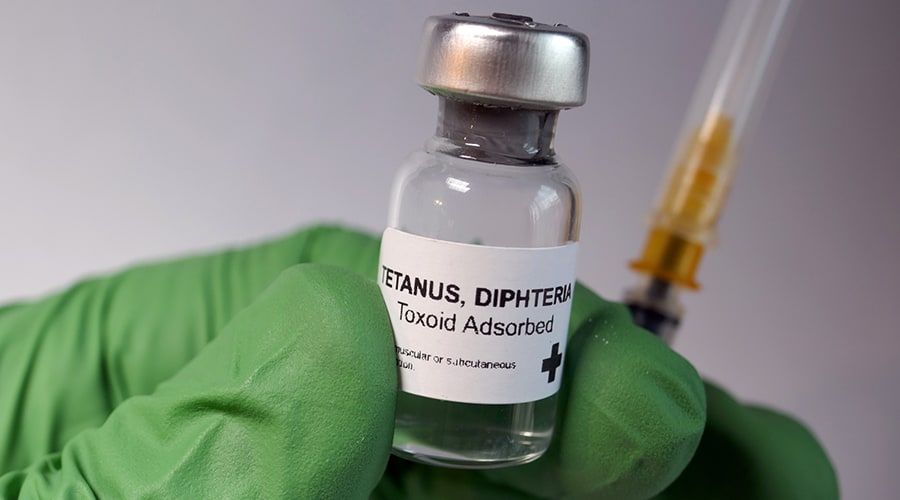
Tetanus (Lockjaw)
General definition and information:
An infection caused by bacteria that invade the body and produce a toxin that causes painful muscle contractions, tetanus is commonly referred to as “lockjaw” because the neck and jaw muscles commonly become tight if the condition is not treated (often as a first sign of symptoms), which can cause difficulty when trying to open one’s mouth, swallow, and/or breathe. Caused by bacteria known as Clostridium tetani (C. tetani), which is commonly found in soil, dust, and manure, tetanus is a bit unique in that it doesn’t spread from person to person like other vaccine-preventable diseases, but it can be fatal. Uncommon in the United States today because of the availability of vaccination, an average of only about 30 cases are reported per year, according to the Centers for Disease Control and Prevention (CDC). CDC officials also report that nearly all cases of tetanus are among people who did not receive all of the recommended vaccinations and those who don’t stay current on receiving booster shots every 10 years.
Other symptoms of the condition include spasms and stiffness muscles throughout the body, seizures, headache, fever and sweating, and changes in blood pressure and heart rate. Serious complications are possible without appropriate and timely treatment and include:1
- uncontrolled/involuntary tightening of the vocal cords (laryngospasm)
- broken bones
- infections, including pneumonia
- blockage of the main artery of the lung or one of its branches by pulmonary embolism
- breathing difficulty, which could lead to death.
According to the CDC, 1-2 of every 10 cases of tetanus are fatal.
Causes & Modes of Transmission:
C. tetani spores typically enter the body through breaks in the skin, often when someone is wounded or there is a breach in the skin and a contaminated object is contacted, resulting in the general form of tetanus. Other causes/forms of tetanus include neonatal tetanus,2 which usually occurs when the umbilical stump is infected, localized tetanus,2 an unusual form of the disease consisting of muscle spasms in a confined area close to the site of the injury that often occurs in those with partial immunity and is usually mild (though progression to generalized tetanus can occur), and cephalic tetanus,2 the rarest form of the condition that is associated with lesions of the head or face and may be associated with otitis media (inflammatory diseases of the middle ear) and can progress to the generalized form of the condition. According to the CDC, most reported cases of tetanus occur in adults, with more than 60 percent of the 264 reported cases between 2009 and 2017 being among people ages 20-64. Of these cases, 25 percent were among people ages 65 and older, and the risk of death from tetanus is said to be highest among those 65 and older, according to the CDC. Diabetes, immunosuppression, and intravenous drug use may be risk factors for tetanus, according to the CDC, which reports that from 2009 through 2017, patients diagnosed with diabetes were associated with 13% of all reported tetanus cases (and 25 percent of all tetanus deaths) while intravenous drug users accounted for seven percent of cases from 2009 through 2017. Natural disasters also pose increased risk of tetanus if survivors and emergency responders do not follow routine vaccination recommendations developed by the CDC3 and if proper wound care is not provided.
Treatment Strategies:
The CDC considers tetanus to be a medical emergency that requires hospitalization and immediate treatment with human tetanus immune globulin (TIG),2 a medication composed of antibodies against the toxin that is used to prevent the condition in those who have been wounded and have not been fully vaccinated. Medications that control muscle spasms, antibiotics, tetanus toxoid booster, and aggressive wound care are also suggested. Depending on the severity of the disease, endotracheal intubation or tracheostomy, and mechanically assisted respiration may be lifesaving, according to the CDC.
Clinicians should begin or continue active immunization with a tetanus toxoid-containing vaccine once the patient’s condition has stabilized following treatment, according to the CDC, and wound care2 will be important. The wound should be cleaned to prevent the growth of spores. But there is no cure for the condition. Bandages should be applied, but new dressings should be used at least once per day (or whenever the dressing becomes wet or dirty). Patients with an allergy to the bandage adhesive can be dressed with a switch to adhesive-free bandages or sterile gauze and paper tape.4
Prevention Parameters:
CDC recommends vaccines for infants, children, teens, and adults to prevent tetanus through use of diphtheria toxoids, tetanus toxoids, and acellular pertussis-containing vaccines.5 The recommended vaccine depends on the patient’s age.6 Healthcare providers are encouraged to educate patients about the lack of serious health problems for most people who receive a tetanus vaccine. Side effects can occur and are usually mild and do not affect daily activities, according to the CDC. That said, those patients who have had a life-threatening allergic reaction after a previous dose of any tetanus or diphtheria-containing vaccine or have a severe allergy to any part of the vaccine, should not be vaccinated.
CDC officials have offered vaccine information statements for healthcare providers and others to learn more about the most common side effects of vaccination.7 The CDC also offers guidance on state vaccination laws and requirements for those who attend public and private schools elementary schools, daycare settings; colleges/universities, and for and healthcare employees and patients in particular facilities.8
References
- Tetanus symptoms and complications. CDC. 2019. Accessed online: www.cdc.gov/tetanus/about/symptoms-complications.html
- Tetanus for clinicians. CDC. 2019. Accessed online: www.cdc.gov/tetanus/clinicians.html#symptoms
- Tetanus Vaccination. CDC. 2019. Accessed online: www.cdc.gov/tetanus/vaccination.html
- Tetanus. Mayo Clinic. 2019. Accessed online: www.mayoclinic.org/diseases-conditions/tetanus/diagnosis-treatment/drc-20351631
- Diphtheria, tetanus, and pertussis vaccination: information for healthcare professionals. CDC. 2018. Accessed online: www.cdc.gov/vaccines/vpd/dtap-tdap-td/hcp/index.html
- People of all ages need tetanus vaccine. CDC. 2019. Accessed online: www.cdc.gov/tetanus/images/tetanus-vacc-media.jpg
- Vaccine Information Statements (VISs). CDC. 2019. Accessed online: www.cdc.gov/vaccines/hcp/vis/current-vis.html
- State school and childcare vaccination laws. CDC. 2017. Accessed online:





